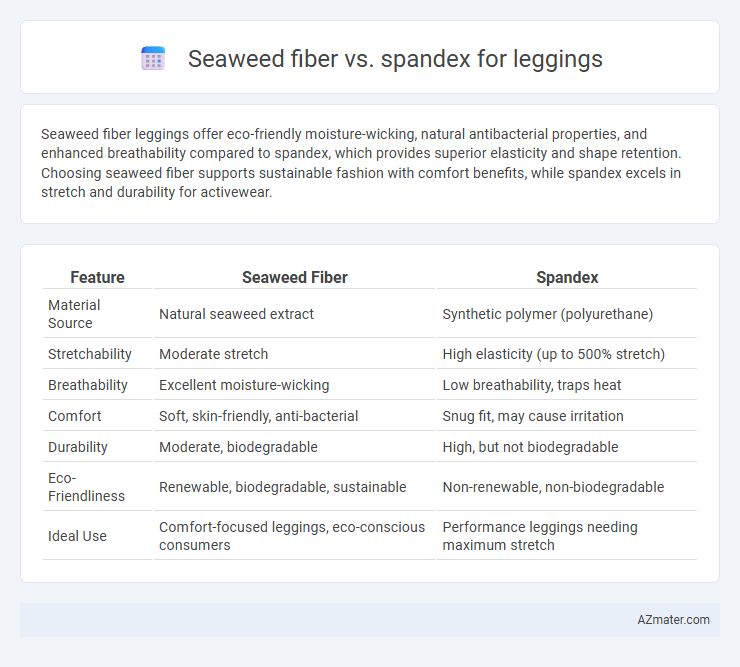Seaweed fiber leggings offer eco-friendly moisture-wicking, natural antibacterial properties, and enhanced breathability compared to spandex, which provides superior elasticity and shape retention. Choosing seaweed fiber supports sustainable fashion with comfort benefits, while spandex excels in stretch and durability for activewear.
Table of Comparison
| Feature | Seaweed Fiber | Spandex |
|---|---|---|
| Material Source | Natural seaweed extract | Synthetic polymer (polyurethane) |
| Stretchability | Moderate stretch | High elasticity (up to 500% stretch) |
| Breathability | Excellent moisture-wicking | Low breathability, traps heat |
| Comfort | Soft, skin-friendly, anti-bacterial | Snug fit, may cause irritation |
| Durability | Moderate, biodegradable | High, but not biodegradable |
| Eco-Friendliness | Renewable, biodegradable, sustainable | Non-renewable, non-biodegradable |
| Ideal Use | Comfort-focused leggings, eco-conscious consumers | Performance leggings needing maximum stretch |
Introduction to Seaweed Fiber and Spandex
Seaweed fiber, derived from natural marine algae, offers sustainable, biodegradable, and moisture-wicking properties that make it an eco-friendly alternative for legging materials. Spandex, a synthetic fiber known for its exceptional elasticity and durability, provides superior stretch and shape retention commonly desired in activewear. Comparing both, seaweed fiber emphasizes environmental benefits and comfort, while spandex prioritizes flexibility and resilience in performance leggings.
Origins and Production Processes
Seaweed fiber, derived from sustainably harvested marine algae, undergoes an eco-friendly process involving the extraction of cellulose and blending with natural fibers, resulting in biodegradable and breathable fabric. In contrast, spandex, a synthetic polymer known as polyurethane, is produced through a chemical-intensive manufacturing process that extrudes long polymer chains into elastic fibers. While seaweed fiber emphasizes renewable resources and lower environmental impact, spandex relies on petrochemicals and energy-intensive production to achieve its signature stretchiness and durability.
Environmental Impact: Seaweed Fiber vs Spandex
Seaweed fiber leggings offer a sustainable alternative to spandex by being biodegradable and derived from renewable marine resources, significantly reducing microplastic pollution in oceans. Spandex, a synthetic polyester-based fiber, contributes to environmental degradation through non-biodegradable waste and energy-intensive production involving fossil fuels. Choosing seaweed fiber leggings supports lower carbon footprints and promotes eco-friendly textile innovation in activewear.
Comfort and Breathability in Leggings
Seaweed fiber leggings provide superior comfort and breathability due to their natural moisture-wicking and antibacterial properties, keeping skin dry and odor-free during extended wear. Spandex leggings offer exceptional stretch and flexibility but tend to retain heat and moisture, potentially causing discomfort during intense physical activities. Choosing seaweed fiber ensures a cooler, fresher experience, while spandex focuses more on elasticity and support.
Stretch and Flexibility Comparison
Seaweed fiber leggings offer natural elasticity with moderate stretch and excellent moisture-wicking properties, making them soft and breathable but less elastic than spandex. Spandex provides superior stretch and flexibility, recovering its shape quickly even after intense movement, which enhances performance in activewear. Combining seaweed fiber with spandex blends comfort and durability while maintaining optimal stretch for dynamic activities.
Moisture-Wicking and Odor Control
Seaweed fiber leggings outperform spandex in moisture-wicking by naturally drawing sweat away from the skin, ensuring a dry and comfortable workout experience. Seaweed fibers contain minerals that inhibit bacterial growth, providing superior odor control compared to spandex, which tends to retain odors after prolonged use. The biodegradability and breathability of seaweed fiber make it an eco-friendly and hygienic alternative to synthetic spandex blends in activewear.
Durability and Longevity in Activewear
Seaweed fiber leggings offer natural durability with resistance to wear and tear, making them suitable for moderate activity levels, while spandex excels in elasticity and recovery, maintaining shape after extensive stretching. Spandex blends often provide superior longevity in high-intensity workouts due to their ability to withstand repeated motion without fabric degradation. Choosing between seaweed fiber and spandex largely depends on the specific activewear demands, with spandex showing greater resilience under frequent and intense use.
Skin Sensitivity and Hypoallergenic Properties
Seaweed fiber leggings offer superior skin sensitivity benefits due to their natural composition and rich mineral content, which helps reduce irritation and promotes skin hydration. Spandex, a synthetic material, often causes discomfort for sensitive skin and may lead to allergic reactions due to chemical treatments used in production. Hypoallergenic properties of seaweed fiber make it an ideal choice for individuals prone to skin allergies, whereas spandex lacks inherent hypoallergenic qualities.
Cost Efficiency and Market Availability
Seaweed fiber leggings offer a sustainable and eco-friendly alternative but tend to have higher production costs due to limited raw material availability and specialized processing techniques, resulting in a higher retail price. Spandex, widely used in activewear, benefits from mass production and extensive supply chains, making it significantly more cost-efficient and readily available in the global market. The economic advantage of spandex drives its dominance in leggings, while seaweed fiber caters to niche consumers prioritizing sustainability despite its premium price.
Future Trends in Legging Materials
Seaweed fiber offers sustainable, biodegradable properties and moisture-wicking capabilities, making it a promising alternative to traditional materials like spandex in leggings. Innovations in seaweed fiber technology emphasize eco-friendly production and enhanced elasticity, addressing the growing consumer demand for sustainable yet performance-driven activewear. Future trends indicate a shift towards hybrid fabrics combining seaweed fiber with spandex to optimize comfort, stretch, and environmental impact in legging materials.

Infographic: Seaweed fiber vs Spandex for Legging
 azmater.com
azmater.com